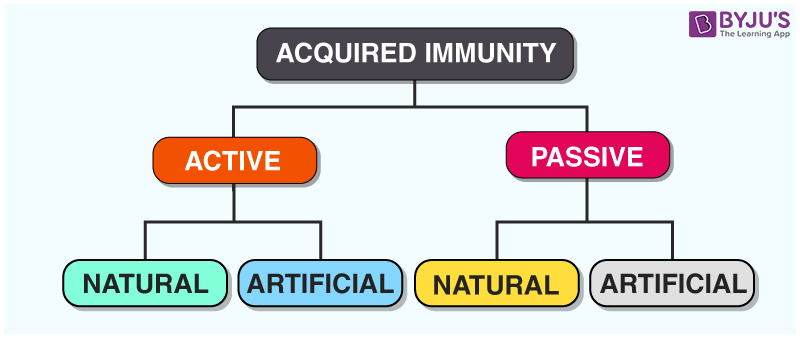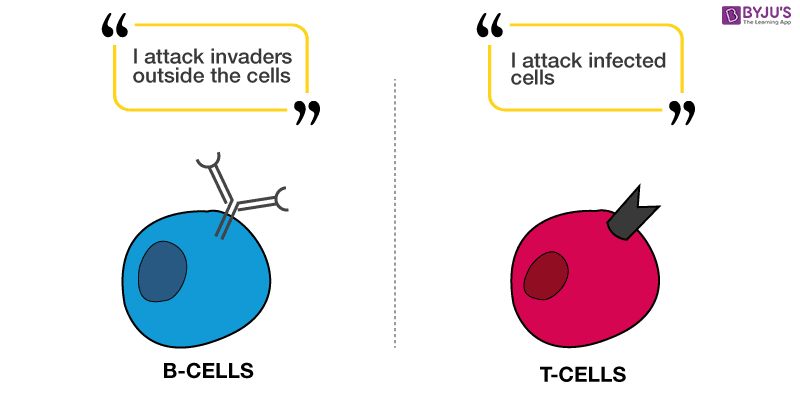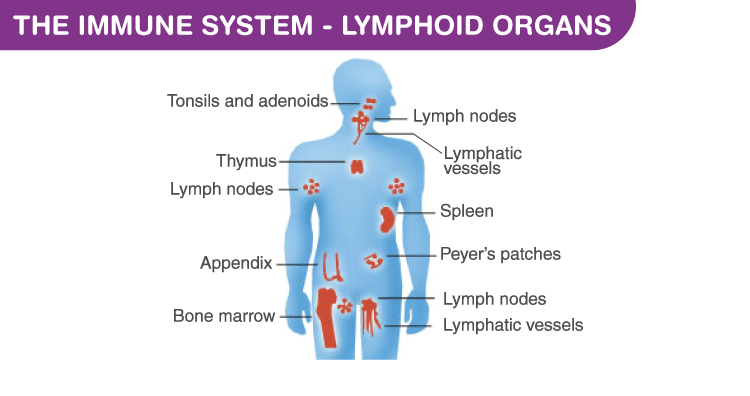What is Immunity?
Immunity is the ability of the body to defend itself against disease-causing organisms. Everyday our body comes in contact with several pathogens, but only a few results into diseases. The reason is, our body has the ability to release antibodies against these pathogens and protects the body against diseases. This defence mechanism is called immunity.
Table Of Contents

Types of Immunity
There are two major types of immunity:
-
Innate Immunity or Natural or Non-specific Immunity.
-
Acquired Immunity or Adaptive Immunity.
Innate Immunity
This type of immunity is present in an organism by birth.
This is activated immediately when the pathogen attacks. Innate immunity includes certain barriers and defence mechanisms that keep foreign particles out of the body.
Innate immunity refers to the body’s defence system.
This immunity helps us by providing the natural resistance components including salivary enzymes, natural killer cells, intact skin and neutrophils, etc. which produce an initial response against the infections at birth prior to exposure to a pathogen or antigens.
It is a long-term immunity in which our body produces the antibodies on its own. Our body has few natural barriers to prevent the entry of pathogens.
Also Read: Antimicrobial Resistance
Types of Barriers
The four types of barriers are:
Physical barrier
These include the skin, body hair, cilia, eyelashes, the respiratory tract, and the gastrointestinal tract. These form the first line of defence.
The skin does more than providing us with fair or dark complexions. Our skin acts as a physical barrier to the entry of pathogens. The mucus coating in our nose and ear is a protective barrier which traps the pathogen before it gets inside.
Physiological barriers
We know that our stomach uses hydrochloric acid to break down the food molecules. Due to such a strongly acidic environment, most of the germs that enter our body along with the food are killed before the further process is carried on.
Saliva in our mouth and tears in our eyes also have the antibiotic property that does not allow the growth of pathogens even though they are exposed all day.
Cellular barriers
In spite of the physical and physiological barriers, certain pathogens manage to enter our body. The cells involved in this barrier are leukocytes (WBC), neutrophils, lymphocytes, basophil, eosinophil, and monocytes. All these cells are all present in the blood and tissues.
Cytokine barriers
The cells in our body are smarter than we give them credit for. For instance, in case a cell in our body experiences a virus invasion, it automatically secretes proteins called interferons which forms a coating around the infected cell and prevents the cells around it from further infections.
Cells Involved In Innate Immunity
-
Phagocytes: These circulate through the body and look for any foreign substance. They engulf and destroy it defending the body against that pathogen.
-
Macrophages: These have the ability to move across the walls of the circulatory system. They release certain signals as cytokines to recruit other cells at the site of infections.
-
Mast Cells: These are important for healing wounds and defence against infections.
-
Neutrophils: These contain granules that are toxic in nature and kill any pathogen that comes in contact.
-
Eosinophils: These contain highly toxic proteins that kill any bacteria or parasite in contact.
-
Basophils: These attack multicellular parasites. Like the mast cells, these release histamine.
-
Natural Killer Cells: These stop the spread of infections by destroying the infected host cells.
-
Dendritic Cells: These are located in the tissues that are the points for initial infections. These cells sense the infection and send the message to the rest of the immune system by antigen presentation.
Also Read: Diseases
Acquired Immunity
Acquired immunity or adaptive immunity is the immunity that our body acquires or gains over time. Unlike the innate immunity, this is not present by birth.
The ability of the immune system to adapt itself to disease and to generate pathogen-specific immunity is termed as acquired immunity. It is also known as adaptive immunity.
An individual acquires the immunity after the birth, hence is called as the acquired immunity.
It is specific and mediated by antibodies or lymphocytes which make the antigen harmless.
The main function of acquired immunity is to relieve the victim of the infectious disease and also prevent its attack in future.
It mainly consists of an advanced lymphatic defence system which functions by recognizing the own body cells and not reacting to them.

The immune system of our body identifies the pathogens which have encountered in the past. It is mainly caused when a person comes in contact with the pathogen or its antigen.
Our body starts producing antibodies to engulf the pathogen and destroy its antigen.
When it encounters for the first time, it is called a primary response. Once a body gets used to these pathogens, antibodies are ready to attack them for the second time and are known as naturally acquired immunity.
The acquired immunity in our body has certain special features.
Features of Acquired Immunity
-
Specificity: Our body has the ability to differentiate between different types of pathogens, whether it is harmful or not, and devise ways to destroy them.
-
Diversity: Our body can detect vast varieties of pathogens, ranging from protozoa to viruses.
-
Differentiate between self and non-self: Our body has the unique ability to differentiate between its own cells and foreign cells. It immediately starts rejecting any foreign cell in the body.
-
Memory: Once our body encounters a pathogen, it activates the immune system to destroy it. It also remembers what antibodies were released in response to that pathogen, so that, the next time it enters, a similar procedure is followed by the body to eliminate it.
Cells Involved in Acquired Immunity
The acquired immunity involves two types of cells: B-cells and T-cells

B-cells
-
They develop in the bone marrow.
- These cells are activated on their encounter with foreign agents. These foreign particles act as foreign markers.
-
The B-cells immediately differentiate into plasma cells which produce antibodies specific to that foreign particle or so-called antigen.
-
These antibodies attach to the surface of the antigen/foreign agent.
-
These antibodies detect any antigen in the body and destroy it.
-
The immunity dependent on B-cells is called humoral immunity.
T-cells
-
They originate in the bone marrow and develop in the thymus.
-
T-cells differentiate into helper cells, cytotoxic cells, and regulatory cells. These cells are released into the bloodstream.
-
When these cells are triggered by an antigen, helper T-cells release cytokines that act as messengers.
-
These cytokines initiate the differentiation of B-cells into plasma cells which release antibodies against the antigens.
-
The cytotoxic T-cells kills the cancer cells.
-
Regulatory T-cells regulate immune reactions.
Also Read:
Types of Acquired Immune Response
Humoral Immune Response
The antibodies produced by B-lymphocytes are present in the blood cells and they are transported all over the body. This is why it is called the humoral immune response as it consists of an antibody produced by the lymphocytes.
It depends upon the action of antibodies circulating in the body. When an antibody on a B-cell binds with an antigen, humoral immunity comes into play. The antigen is internalized by the B cell and presented on the helper T cell. This activates the B-cell.
The activated B cells grow and produce plasma cells.
These plasma cells release antibodies in the bloodstream. The memory B cells retain the information about the pathogen to prevent any disease caused by that pathogen in the near future.
Cell-mediated Immune Response
Cell-mediated immunity is initiated by the T helper cells.
The cytotoxic T cells eliminate the infected cells from the body by releasing toxins, thereby, promoting apoptosis or programmed cell death.
The T helper cells help to activate other immune cells. Cell-mediated immunity becomes clear in the case of transplant patients.
When any of our sense organs stop functioning, it can be transplanted to replace the malfunctioning organs. But it is not that simple with the immune response. It appears that T-lymphocytes are capable of recognizing whether tissue or an organ is from our body or foreign bodies. This is the reason why we cannot transplant and implant the organs into our body even if we find the donor with the same blood group because our body might reject the transplanted organ. The T-cells quickly recognize that the tissue or an organ as a foreign and do not allow it to become a part of the body. This is why transplant receivers have to take immunosuppressant medication for the rest of their lives. This response is controlled by the T-lymphocytes.
Types of Acquired Immunity
Active Immunity
Active immunity involves the direct response to a foreign antigen within the body. In the case of the acquired or adaptive immune system, the body remembers the pathogens it has encountered in the past. This is a direct result of the active immune system.
Active immunity occurs when we are in contact with the pathogen or its antigen.
Antigens stand for antibody generator. It is with the help of antigens released by the pathogen that our body tackles the pathogen.
So what our body does is, it starts producing antibodies to attack the pathogen based on its antigen. When this happens for the first time, it is called a primary response. Once a body experiences a pathogen for the first time, it keeps a few of the antibodies that attacked the pathogen just in case it attacks for the second time. This is known as natural active immunity.
Passive Immunity
Passive immunity involves the immune response by the antibodies attained from outside the body. The primary response by the body to a pathogen it encounters for the first time is rather feeble, so the first encounter is always a little harsh on the body.
What if we could immunize everyone without the need for them ever getting sick?
Biotechnology has grown tremendously in the last decade or two and now we are capable of manufacturing antibodies for diseases. These ready-made antibodies protect the body even if the body hasn’t yet experienced a primary response.
While active immunity may protect us from a disease for a lifetime, passive immunity is the more short term.
Passive immunity develops immediately and our body could begin its attack on the pathogen right away.
There are two types of passive immunity:
-
Natural Passive Immunity
-
Artificial Passive Immunity
AutoImmunity
Sometimes the immune system attacks its own tissues and organs instead of the foreign agents. This is called autoimmunity. Type I diabetes is an example of autoimmune disease.
Vaccines
A vaccine is made up of the antigens of the pathogen that cause the disease. For eg., the smallpox vaccine contains the antigens of the pathogen causing smallpox disease. When a person is vaccinated with the smallpox vaccine the antibody-producing cells are stimulated that produce smallpox antibodies. Thus, the body is protected against the disease occurring in future.
Vaccinating pathogenic microbes into our body deliberately produces a similar response and is termed as artificially acquired immunity.
Immunization is a process providing resistant to pathogenic microbes and other infectious diseases by the administration of a vaccine into the body. By immunization, it stimulates the body’s immune system to protect against subsequent infection or disease.
Also Read: Difference between active and passive immunity
Immune System

The immune system is our body’s best defensive system. It functions against infringing microorganisms and keeps us healthy.
Immunology is a branch of biology which deals with complex body functions of the immune system. The ability to tackle antigens or pathogens and being healthy is referred to as immunity.
The immune system is composed of cells, tissues, and organs that work unitedly in protecting our body. This system defends the human body from the trespassing pathogens in a variety of ways. They work based on memory, some are innate, and some are acquired. Hence, they function in allergies, autoimmunity and organ transplantation.
The most important cells involved in the immune system are white blood cells (or) leukocytes, which are involved in destroying disease-causing organisms or substances. Apart from the leukocytes, lymphoid organs, tissues, and proteinaceous molecules antibodies are also involved in the defensive system.
Read more: Cytokines: Meaning, Functions and FAQs
Lymphoid Organs
The organs of the immune system which are involved in defending the body against invading pathogens causing infections or spread of tumours is termed as Lymphoid organs. It includes bone marrow, blood vessels, lymph nodes, lymphatic vessels, thymus, spleen, and various other clusters of lymphoid tissue.
Lymphoid organs are the site of origin, maturation, and proliferation of lymphocytes. They exist as primary, secondary or tertiary and these are based on their stage of development and maturation.
These organs consist of fluid connective tissues with different types of leukocytes or white blood cells. The highest percentage of Lymphocytes are present in the white blood cells or leukocytes.
Primary lymphoid organs
The primary lymphoid organs produce and allow the maturation of lymphocytes. It also serves by generating lymphocytes from immature progenitor cells. Therefore it is referred to as the central lymphoid organs. Examples of primary lymphoid organs include thymus and the bone marrow.3
Secondary lymphoid organs
The secondary lymphoid organs are referred to as the peripheral lymphoid organs as they are involved in promoting the sites for the interaction of lymphocytes with the antigen to become effector cells. They initiate an adaptive immune response. The secondary lymphoid organs Examples of secondary lymphoid organs spleen, tonsils, lymph nodes, appendix, etc. are secondary lymphoid organs.
Tertiary lymphoid organs
The tertiary lymphoid organs usually contain very less number of lymphocytes. It plays an important role during the inflammation process.
Also Read: Principles of Prevention
This is about immunity, their types- innate and acquired immunity, B cells, T cells, Humoral and cell-mediated immune response and the immune system.
Learn more in detail about immunity, their functions and other related topics at BYJU’S Biology.

How to download this article
English
Class 10 selection tes